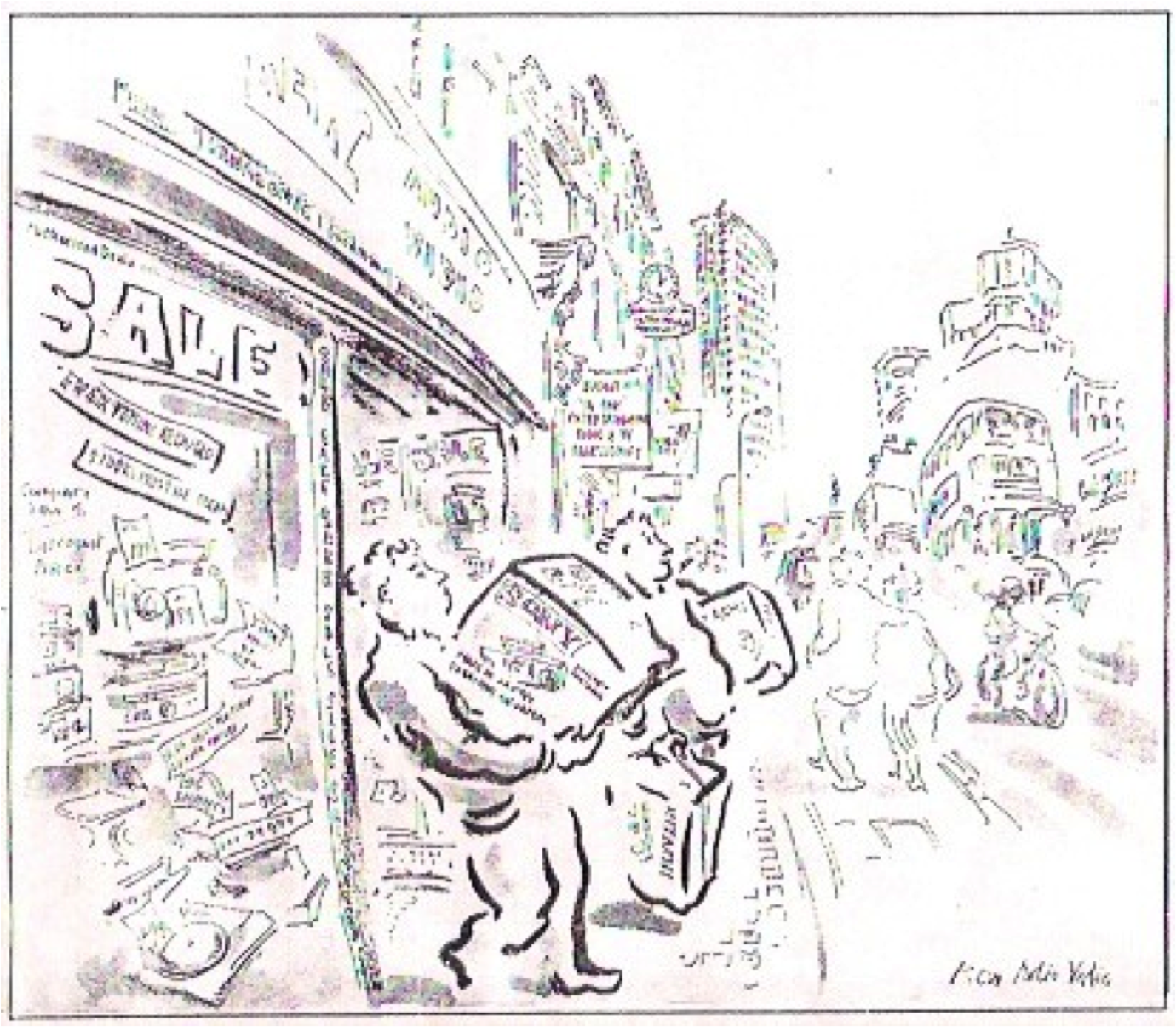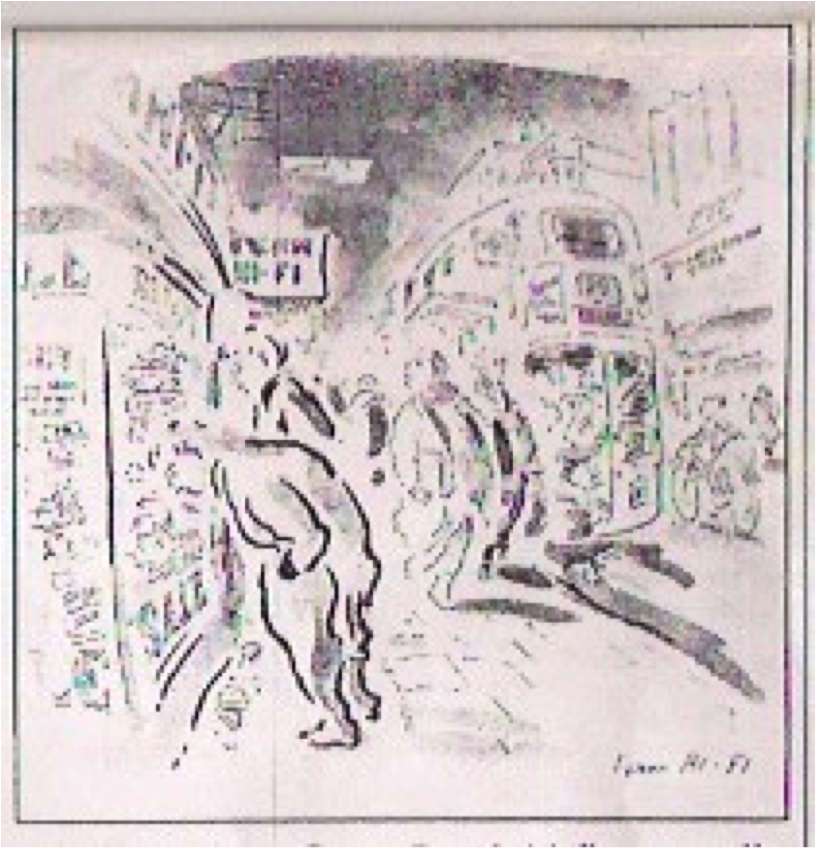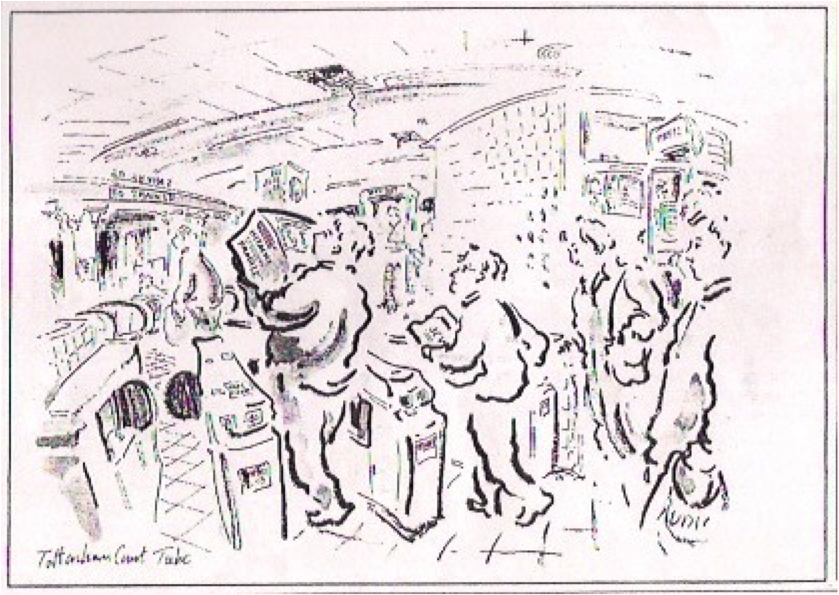Silicon High Street
 First published in Blueprint, March 1984
First published in Blueprint, March 1984London’s Tottenham Court Road, Mecca for hi-fi freaks, is a fascinating place. Part department store, part bazaar, it contains an unexpected lesson: all the over-heavy feature innovation that’s supposed to be unique to the arms sector goes on in hi-fi, too
llustrations: Paul Cox
There are no guides to Tottenham Court Road. Hi‑fi mags don’t talk about it; there are no articles in the press about it; it is not a tourist attraction. In the late 1970s there was a thing done by LWT’s London Programme about the price‑fixing cartels run by the hi‑fi dealers on the street, but that is all. Surprising, really, because Tottenham Court Road is definitely Where The Action Is.
First there’s action in the literal, physical sense of the word. To go up the Road on a rainless weekday, and especially on a sunny Saturday afternoon, is to see humanity gone berserk. Inside the shops, you have to queue and shout above the computer games to get beleaguered service. Outside, people are carrying out thousands of pounds of anodised aluminium, liquid crystal displays and machines with low signal-to-noise ratios. The scrummage is fierce. The hard cash changing hands is difficult to wrap your brain around. There are not only the embarrassed Clapham couples loading £300 sofas on top of the Renault outside Habitat; there are the 16-year-olds from Woking with the same kind of money to spend on radios and stereo amps you can adjust by remote control. There are health administrators wondering whether their shoulder‑mounted boom‑microphoned Panasonic autofocus video camera will hook up with the old Phillips machine they’ve shipped over to that second home on the Isle of Wight. Tottenham Court Road is a year-long Harrods sale, but the old dears grabbing for the piles of plates have turned into Ford Capris, double‑parked on double yellow lines, red rear warning lights winking, black boots yawning wide, ready to receive.
REW Audio Video
Second, there’s the design action. Of course, there’s the obvious kind: Conran’s Habitat, his newly-acquired Heals (currently closed for works, as the wonderful curved windows face extinction at TC’s hands), textile czar Eddie Pond’s Paperchase, furniture manufacturers Herman Miller and Hille. Then there’s the mid-market stuff – the Reject Shop, Time Out furnishers Adeptus. Some of the other stores also have a weird, off-beat design charm to them: copperware specialists Leon Jaeggi & Sons, telescope buffs Scientific & Technical (giant reflectors with equatorial drive, £999), tool stockists Buck and Ryan, plus the magical Proops, purveyors of every kind of second‑hand electronic widget. But the real design action is that going down in the hi-fi shops.
From the standpoint of retail design, the exteriors and interiors of the hi‑fi shops contrast greatly. On the outside, they are all fluorescent tubes, awful decals, cardboard arrows, felt‑tip penned prices, raucous packaging and weasel words. ‘Tax-free export arranged,’ three-hour Maxell VHS videotapes down to £55 the dozen, the ‘Hipster’ (a down-market Walkman rip-off). On the inside, the big shops are dark, labyrinthine, a million displays lit up: amusement arcades where American Express, not coins, is the going currency. Once, I stumbled into the monumental Lion House, escalators and emergency exit signs everywhere. In the gloom were banks and banks of colour TV sets, two-inch to projection-screen size, all luminous with the Roman-Polanski-slashes-Jack-Nicholson’s-nose scene from Chinatown. It had been taped from the telly the previous night by an enterprising Asian man. His forte was the battery recharging units you get with portable video recorders.
Even the smaller shops, which sell just accessories, have curious interiors. Behind the glass swing-doors are cables, interfaces, Ortofon cartridges and complete record care and cleaning systems which will set you back the price of 12 LPs. They are hung from the ceiling and set next to glistening calculators in Perspex point-of-sale dispensers.
So in retail design terms the Road’s hi‑fi dealers are part department store, part bazaar. But when we come to the goods on sale the design action is beyond belief. Pressed up against the windows, behind thick thief-proof chains at night, are rows of white, matt, beautiful Apricot computers, all with winsome VDUs. Reduced from £899 to £850 is the portable Commodore 64, a fine mixture of Pacific Basin and Bauhaus idioms. Admire the Technics record decks, each with a spotlight built into its arm so that its stylus is illuminated; you hang them vertically from walls. The compact discs, which flash spectrums at you, appear unaffordable and impossibly complex. ‘Further reduced’ say the cardboard arrows pointing to impossibly small stereo stacks made by Aiwa. And now the JVC video recorders come with big red Reverse, Play and Fast Forward buttons – a major concession to product intelligibility.
TEAM Hi-Fi
What is the significance of all this? The significance of Tottenham Court Road is that it is the world’s most hectic forum for design as a weapon of commercial competition. And here ‘weapon’ is the right word. Hi-fi on the Road doesn’t just look military: the parallels between the international hi-fi business and the international arms industry go deeper than this.
In hi-fi competition is by technological innovation much more than price. And the innovation is very rapid and very surprising – who’d have thought, a few years ago, that VCRs would have little green lights that come on when dew builds up inside them? The problem for the giant manufacturers like Sharp and Sanyo, however, is to convey the presence of the new functions to the punters in the street. It therefore falls to industrial designers to make the pitch. The men doing the selling, behind the counters are likely to be too behind the times, or, in the case of Tottenham Court Road, too harassed to explain the new season’s delights.
In hi-fi, you buy to impress your friends visually, not aurally. So for the manufacturers the pressure is on to cram on to one gleaming fascia as many voltmeters, impedance graphs and secret pop-open compartments as possible. Most of these are functionally redundant, and in ergonomic terms the Creeping Feature Syndrome is a disaster. But the packaging of these features is what makes the difference in sales. Industrial design positions the product. It is what allows yesterday’s ghetto-blasters to masquerade as audio systems essential to today’s living rooms; it persuades the people who care about wow and flutter to buy their next tuner as part of a total video-in-stereo rig.
Now to the military parallels. A glance at The Baroque Arsenal (Andre Deutsch, 1982; now in paperback), by left-wing Labour defence expert Mary Kaldor, shows how superficial theorists who complain about the ‘military-industrial complex’ are. All the trends that Kaldor feels are so unique to the arms industry go on in hi-fi too. Each enhancement of performance, be it of loudspeakers or multirole combat aircraft, tends to bring fewer pro rata benefits than the last. Each, too, means that the system in question requires more logistical back-up than ever before (more accessories, more software, more skilled service personnel to deal with problems), which in turn makes it as dear to operate as to buy. Despite all the technological sophistication, both types of system have a habit of going wrong: ‘human errors’ occur (tapes being loaded the wrong way, radar screens with the brightness control turned too far down) occur, particularly in the most tense situations (a dance‑party about to start, a Task Force about to engage). In hi-fi and arms alike, we are in the age of machinery which serves little useful purpose but to earn its makers money and make its owners feel good.
The indirect parallels with the business of war‑mongering are, perhaps, even more peculiar. When we remember that conventional, non‑nuclear weapons take the lion’s share of military budgets, the possibility that the world of hi‑fi might overlap with that of organised death becomes clear enough; when we notice the current vogue for electronics-based conventional weapons, the overlap becomes a reality. Though they still spend little more than one per cent of their GDP on defence, the Japanese show, through their expertise in hi-fi, that they could beat the Americans hands down when it comes to ‘ET’, the ‘Emergent Technology’ of electronically-guided anti-tank munitions and electronic battlefield surveillance. Indeed in reliability, and in the integration of one electronic system with another (the VCR as stereo again), the Japanese have shown through hi‑fi that they can take on anybody. As the major hi‑fi manufacturers slug it out with each other on Tottenllam Court Road, therefore, they suggest larger, genuinely lethal battles ahead. The iconography may be baroque, but every participant in the escalating hi‑fi race is in deadly earnest.
Tottenham Court Road tube
In Tottenham Court Road, hi-fi eventually reduces itself to two stores – Sarays and Gultronics. Both are run by a Croydon-based family of South Yemenis, who insist proudly that they are from Aden. Sarays is a continuous auction, gear being thrown down from a visible mezzanine at the rate of about £1000 a minute, a teenage member of the family on the door to make sure that none escapes unpaid for, eager managers ready to bargain over prices and full of promises to ‘look after you.’ Gultronics, a hilarious elision of ‘Gulf’ and ‘Electronics’, is an Aladdin’s cave, sepulchral and packed with goodies. Both offer superb prices; both confirm the military metaphor.
When Blueprint approached the two shops with a request for an in-depth interview, they turned us down. Despite the fact that they’re on the same street as Habitat and Heals, a design magazine like Blueprint was not, they said, the kind of medium they would want to be in. Not even if they were on the cover. No matter: just as the military men keep themselves to themselves, so do the hi-fi dealers. But go to Sarays and Gultronics, look at their wares. It is hard not to think of Iraq’s Exocets, of Saudi Arabia’s AWACS systems and of all the other electronic hardware being fielded in Beirut and near the Straits of Hormuz. There, on the street that boasts four bilious-green Underwoods chemists and a Church of Scientology to boot, a metaphor for a terrible future is on show for all to see.
Fmr President of Kenya on Trump cutting off foreign aid:
“Why are you crying? It’s not your government, he has no reason to give you anything. This is a wakeup call to say what are we going to do to help ourselves?”
America first is good for the world.
Our entire Green Socialist establishment should be banged up under the ‘Online Safety’ laws, for spreading demonstrable lies (the ‘climate crisis’), causing non-trivial harm to the industrial working class, ordinary drivers, farmers, taxpayers etc, etc.
#Chagos? #Mauritius PM Navin Ramgoolam "is reported to want Starmer to pay £800m a year, plus ‘billions of pounds in #reparations’." (14 January) https://www.spiked-online.com/2025/01/14/the-chagos-islands-deal-is-an-embarrassment/
Now the Torygraph wakes up https://telegraph.co.uk/gift/1ff8abbb462cd609
Read @spikedonline - first with the news!
Articles grouped by Tag
Bookmarks
Innovators I like

Robert Furchgott – discovered that nitric oxide transmits signals within the human body

Barry Marshall – showed that the bacterium Helicobacter pylori is the cause of most peptic ulcers, reversing decades of medical doctrine holding that ulcers were caused by stress, spicy foods, and too much acid

N Joseph Woodland – co-inventor of the barcode

Jocelyn Bell Burnell – she discovered the first radio pulsars

John Tyndall – the man who worked out why the sky was blue

Rosalind Franklin co-discovered the structure of DNA, with Crick and Watson

Rosalyn Sussman Yallow – development of radioimmunoassay (RIA), a method of quantifying minute amounts of biological substances in the body

Jonas Salk – discovery and development of the first successful polio vaccine

John Waterlow – discovered that lack of body potassium causes altitude sickness. First experiment: on himself

Werner Forssmann – the first man to insert a catheter into a human heart: his own

Bruce Bayer – scientist with Kodak whose invention of a colour filter array enabled digital imaging sensors to capture colour

Yuri Gagarin – first man in space. My piece of fandom: http://www.spiked-online.com/newsite/article/10421

Sir Godfrey Hounsfield – inventor, with Robert Ledley, of the CAT scanner

Martin Cooper – inventor of the mobile phone

George Devol – 'father of robotics’ who helped to revolutionise carmaking

Thomas Tuohy – Windscale manager who doused the flames of the 1957 fire

Eugene Polley – TV remote controls





0 comments